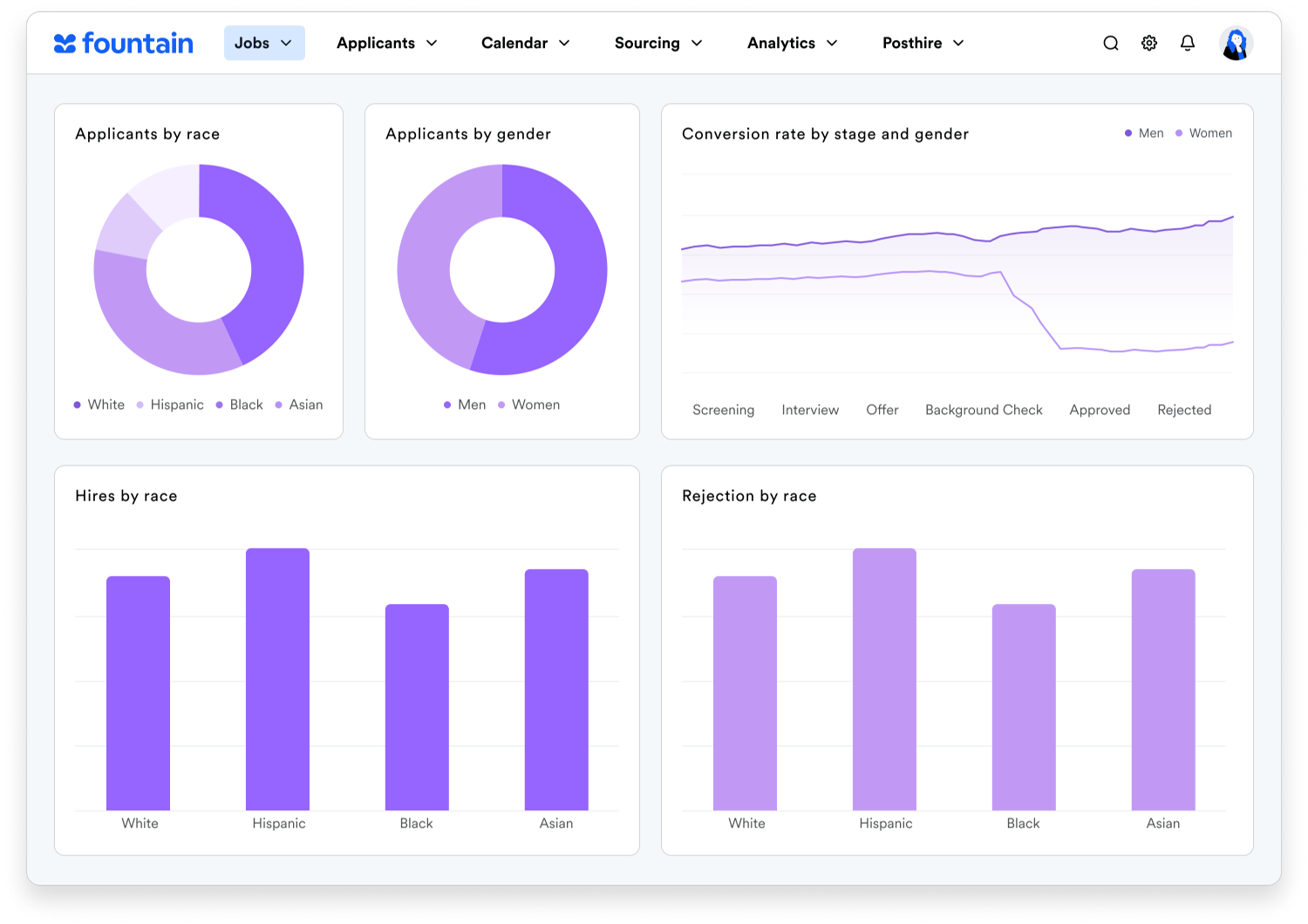Is your recruiting and hiring process compliant? If you have to ask yourself this question, the answer might be no. But don’t worry—we’re here to guide you through an HR compliance audit: an evaluation of your recruiting workflow to identify opportunities for compliance implementation, ensure these are applied at all applicable stages, and maintain frequent compliance checks so you’re always up to date.
But first, we’ll cover some HR compliance basics so you can start building your strategy based on your unique recruiting needs and wants.
The purpose of an HR compliance audit
Why do you need to perform an HR compliance audit? Because you need to ensure your HR functions are following federal, state, and local laws. An audit can help organizations minimize legal liabilities and create a respectful work environment where all workers feel safe and protected.
HR compliance covers a wide variety of areas in recruitment, such as data privacy, discrimination, anti-harassment, and other policies. By evaluating your internal hiring functions for compliance, you can make sure your operations are fair, ethical, and legally sound.
For your workers, clear insight into your workforce compliance status can help ensure your employees stay eligible for work and can help reduce churn due to non-compliance.

What areas are addressed in an HR compliance audit?
Depending on your business sector, industry, and location, you may be required to adhere to specific regulations regarding employment. The most common areas of compliance include the following:
- Labor laws—These are enacted by the U.S. Equal Employment Opportunity Commission (EEOC), the Wages and Fair Labor Standards Act (FLSA), the Family and Medical Leave Act (FMLA), and the Americans with Disabilities Act (ADA).
- Data privacy and security—
- Safety and health regulations—Regulations put forth by the Occupational Safety and Health Administration (OSHA).
- Employment classification—Under the FLSA mentioned above, employees must be identified as exempt (typically receive a salary, not eligible for overtime pay) or non-exempt (typically paid hourly, eligible for overtime pay).
- Employee records—Collection and storage of legal documentation, such as an I-9 for identification, tax documents, and all payroll information.
The HR compliance audit process explained
Assess current practices
Take stock of any current initiatives in place that contribute to your HR compliance practices. This may involve interviewing your current employees and reviewing handbooks and other HR documents as part of a greater investigation process into policies.
Identify and qualify violations
Before you begin your HR compliance audit, make a note of what you’re planning to keep an eye out for in terms of policy violations. You also may want to establish a method of flagging, keeping track, and working to remedy these violations.
Issue audit report and analyze your findings
After the audit is complete, it’s time to start building your report and analyzing the information you’ve collected, Prepare to issue a final report to management for approval.
The importance of an HR compliance audit checklist
An HR compliance checklist can help you organize and strategize what steps you need to take as part of an HR compliance audit. With a checklist, you can make sure you’re covering all your compliance bases and getting ahead of potential audits from external entities.
Your checklist may cover the following aspects of your workplace:
- Recruitment—Job descriptions are free of discriminatory language, such as mentioning of specific genders, races, nationalities, sexual orientations, or veteran statuses.
- Interviewing—Use questions that don’t cross any legal or ethical boundaries and instead, stick to questions that are solely about the position and the interviewee’s qualifications for the role.
- Onboarding—Structured process for new hires that includes document collection (e.g., I-9 for employee identification, W-4 for taxes).

- Worker classification—Correctly identify workers as exempt or non-exempt to comply with FLSA regulations regarding whether overtime pay is allowed.
- Payroll—Make sure all non-exempt workers are paid at least the federal minimum wage, and if your state’s minimum wage is higher, then you’ll need to meet those regulations. In addition, audit employees’ time cards and other payroll records to make sure your employees’ time worked is taken into account and easy to access for those who need to review it.
- Benefits—If you have more than 50 employees and are considered an applicable large employer (ALE), you are required to provide health insurance to your qualifying employees. You also should check whether you are required to offer retirement plans and medical leave (under FMLA).
- Safety—Review safety practices outlined by OSHA and perform regular safety audits and training for all staff.
- Data protection—Employee data, such as health information, background checks, and other hiring data, need to be secured and the act of securing it needs to be communicated to employees.
- Other employment policies—Ensure your hires have access to an employee handbook where they can learn and review best practices, vacation allowance, sick days, and other policies.
As a final note, it helps to set a deadline for when you plan to complete the audit and share out the results.
Tips for conducting an HR compliance audit
Here are a few HR compliance audit tips to help you establish a regular and efficient compliance process.
- Be proactive to get ahead of audits—Don’t wait for issues to arise; be proactive in your HR compliance auditing initiatives rather than reactive in light of a policy violation.
- Get buy-in from HR leadership—Approach your top management to discuss the necessity of the audit and get insights into how to effectively conduct the audit with disrupting normal business operations.
- Inform your team of your audit intentions—Before you begin your HR compliance audit, inform your team about when the audit will take place, what the audit will involve, and what you’re hoping to get out of the audit.
- Choose your internal auditors—Gather your recruiting team and figure out who will be participating in the audit process. You may even decide to bring in an outside organization who specializes in HR compliance audits.

- Document every step—Keep records of all job applications, interviews, and other application documents to track compliance over time. From this information, you’ll build your detailed report.
- Review findings—During this step, you’ll review and analyze your findings to identify possible compliance issues and opportunities for improvement.
- Disseminate findings—Once you have your findings, think about the best ways to distribute your report. These may include in a written report and an in-person meeting with a presentation. Allow time for questions and answers from your leadership team.
- Make a plan to implement changes—Outline steps to address problematic areas, prioritizing those that may have legal consequences.
Challenges in the HR compliance audit process
Conducting an HR compliance audit can present a few challenges. Read below to learn about what to look out for and how to handle them if and when they arise.
Regulatory changes and nuance
Generic compliance frameworks may not address specific regulatory nuances, resulting in a less effective and adaptable compliance strategy. Standardized compliance solutions may not accommodate the specific requirements of the business, hindering adaptability and efficiency.
Data entry and integration
Lack of real-time compliance status updates may cause confusion and disengagement, leading to a less informed and connected workforce.
Communication
Inadequate communication about compliance expectations may result in misunderstandings, impacting worker engagement and trust.
Fountain’s approach to HR compliance audits
Fountain Compliance simplifies workforce management and eliminates compliance headaches with AI verification and IDP technology, providing transparent oversight of compliance status, and ensuring a seamless workflow.
See how to use Fountain Compliance to facilitate your own compliance practices.

